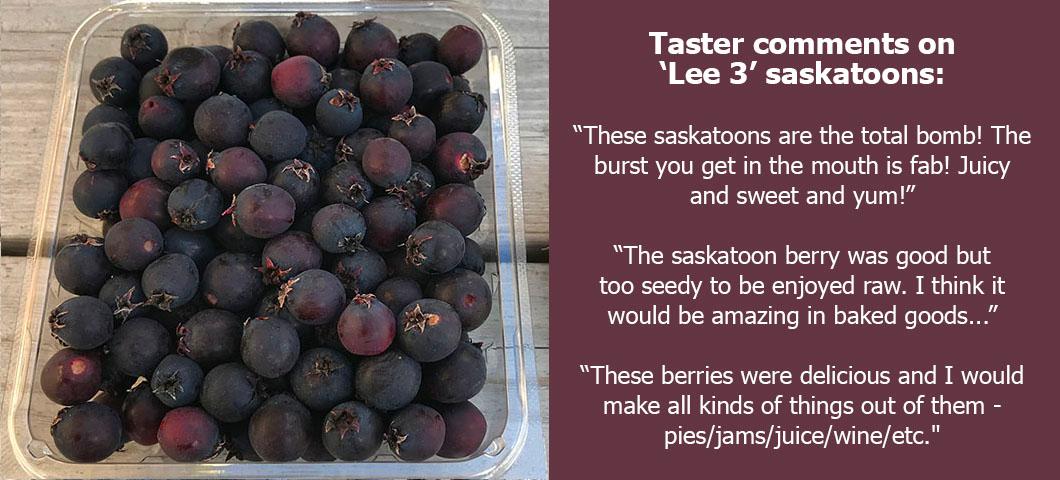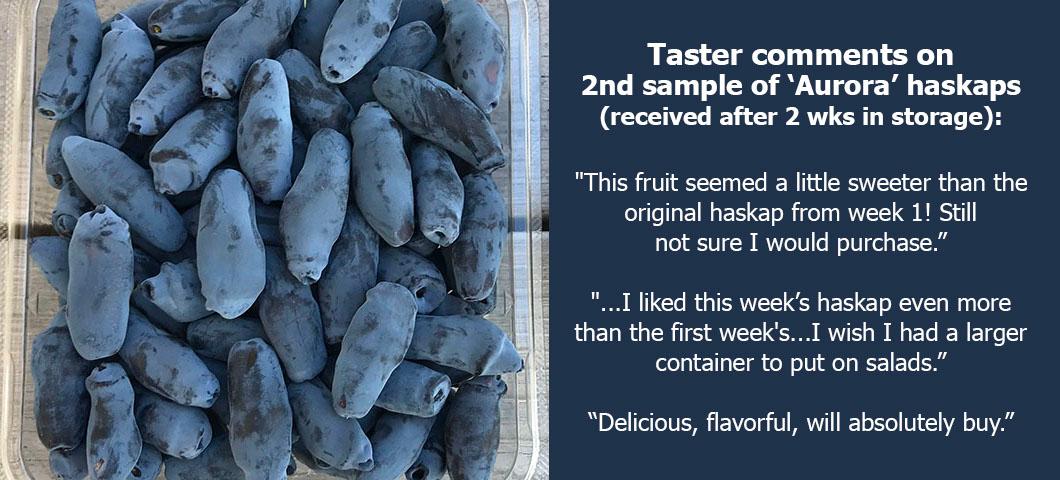Taste tests of novel fruits for Montana markets
Fresh haskap, saskatoon, and dwarf sour cherry consumer study 2020 (see also full report PDF)
Background
Haskap (Lonicera caerulea), saskatoon (Amelenchier alnifolia), and dwarf sour cherry (Prunus x kerrasis) bushes can withstand Montana’s cold winters and produce fruit in a short growing season. We believe that growing and offering these fruits for sale is a potential opportunity for Montana growers, consumers, and visitors to both produce and taste something special from Montana. However, we had little information regarding how well these novel fruits would be accepted by potential customers. With funding from the Montana Department of Agriculture Specialty Crop Block Grant, we partnered with the Western Montana Growers Cooperative (WMGC) and the MSU Food Product Development Lab to conduct consumer acceptance tests for these three species. Fruit samples were provided to WMGC community supported agriculture (CSA) share members who signed up to participate in these taste tests over the course of four weeks. Members rated fruit likability (on a 1-to-9 rating scale, with 9 being “like extremely”) as well as purchase likelihood and willingness-to-pay.
Results indicate:
- Fresh haskaps (variety ‘Aurora’) seem likely to be a commercial success, with an average acceptance rating of 7.66 and excellent storage duration. We refrigerated the Aurora haskaps (34° F and 97% relative humidity) for two weeks before sending fruit out for a second consumer evaluation. CSA members rated the stored fruit just 0.01 less than initially, at 7.65. There are many haskap cultivars available with differing ripening times that would allow for an extended fresh-market harvest: we harvested fruit from mid-June to mid-July this year. We have learned there is great diversity of flavor in haskap varieties—some are excellent for fresh eating and some we’ve consigned to wine-making only!
- Fresh saskatoons (variety ‘Lee 3’) were rated lower than haskaps, at an average of 6.21, but comments suggest that there still could be a fresh market for these fruits among a smaller segment of the community. Saskatoons may be a good fit for a U-pick, as plants are tall and easy to harvest without stooping. We and others (Saskatoon Berry Production Manual) have observed that the fresh fruits degrade quickly in storage, and we noted they seem to lose flavor when chilled. We recommend selling them within a few days of harvest.
- Fresh sour cherries (variety ‘Romeo’) were rated at 5.74. Many of the comments indicated that consumers appreciate the fruit's flavor, but—due to its tartness—would prefer to use it for processing rather than fresh eating. We advise any growers considering selling this fruit fresh to leave the stems intact. If the stems are removed, fruit will shrivel overnight. Note that the University of Saskatchewan has a ripeness guide based on color for ‘Romeo’ and other dwarf sour cherries.
- We recommend pricing the fruit between $2.10 and $4.70 per 6-ounce container, according to the survey ranges in the table below. However, each grower or marketer should factor in production costs and consumer audience in this decision. For further discussion, please visit the Montana Berry Growers Association’s Facebook page.
|
Fruit Type |
Average willingness-to-pay (WTP) |
|
Haskaps |
$3.70 ± 1.00 A |
|
Haskaps stored for 2 weeks |
$3.70 ± 1.00 A |
|
Saskatoons |
$3.00 ± 0.90 B |
|
Dwarf Sour Cherries |
$3.10 ± 1.00 B |
AB Samples with the same letter code in any column did not significantly different from one another regarding WTP.

!['Romeo' dwarf sour cherries Taster comments for 'Romeo' dwarf sour cherries:
"I love the tartness....definitely like the idea of juice or dried fruit snacks/fruit leather made with these."
"Great texture and freshness, too tart to eat alone, may be good in jelly or other prepared goods."
"The hardest part...would be buying them over the cheaper Flathead [sweet] cherries that are available."](https://agresearch.montana.edu/warc/_ldp/.private_ldp/a256047/production/master/840129d9-55ba-4200-9037-b0c47af14a7b.jpg)



